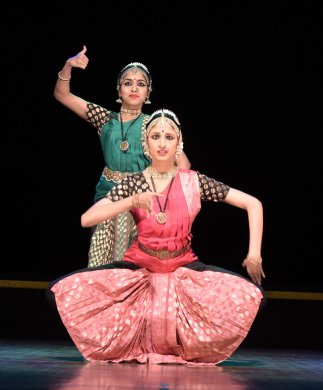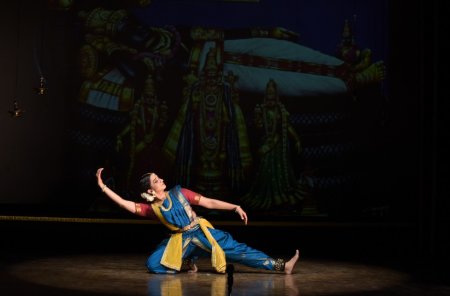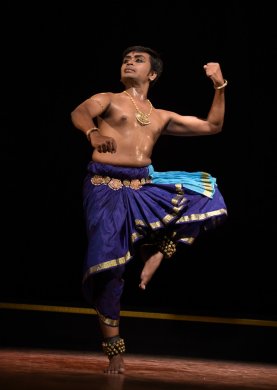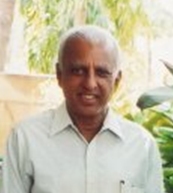
|   |

|   |
Padmalaya Dance Foundation presented Youth in Dance Festival - Satish Suri e-mail: satishism@yahoo.co.in Photos: Shandilya Srivatsa June 19, 2023 The festival began with a unique challenge for artistes, inviting them to explore the poetry of renowned poets through Bharatanatyam.  Anindita Ashok and Poshni Zunzurwad Anandita Ashok and Poshni Zunzurwad from the Padmalaya Dance Foundation took to the stage and presented a delightful rendition of Pattammal's Tamil adaptation of Kalidasa's classic "Kumara Sambhavam". The performance narrated the events surrounding the birth of Skanda, who was destined to vanquish the demons Tarakasura and Surapadman causing havoc in the world. Indira, desperate for a solution, appealed to Brahma who revealed that only a child born from the union of Shiva and Parvati could defeat the demons. To disrupt Shiva's meditation, Manmatha was sent, but Shiva sees through the plan and reduces him to ashes. Undeterred, Shiva approaches Parvati as an old man but his attempts were in vain. Finally, Shiva reveals his true identity, understanding Parvati's yearning. The union of Shiva and Shakti gave birth to the radiant Skanda (Muruga), who eventually destroyed the demons. The performance paid homage to the divine story with the invocation, "Om Subrahmanyaya Namaha." Anindita Ashok and Poshni Zunzurwad displayed impeccable synchrony, presenting an absorbing portrayal filled with nuances. Their movements and expressions showcased remarkable versatility, particularly during the rhythmic sequences where the demons were vanquished, adding a vibrant and energetic note to the performance. The recorded music track featuring Vasudha Sastry (vocal), Prasanna Kumar (nattuvangam), G.Gurumurthy (mridangam) and Shubha Santosh (veena) complemented and enhanced the dancers' every move and expression. Janani Murali's choreography added a distinctive and captivating touch, enriching the overall presentation.  Ramya Suresh Ramya Suresh, a student of Indira Kadambi, chose to delve into the poetry of Late Harini GNT, the mother of Indira Kadambi, in her exposition titled "Karunaada Manye".The performance beautifully traced the journey of the river Cauvery from its origin in the Brahmagiri hills to its ultimate merging with the ocean. The narrative depicted the river's various aspects, such as its childlike innocence, its nurturing and compassionate nature, and its ability to sustain and nourish all forms of life including vegetation, animals and humans. The exposition highlighted significant milestones in the river's course, including its symbolic marriage at Poompuhar in Tamilnadu and its gentle caress of the three sacred sites, Sri Adi Ranga, Madhya Ranga and Sri Ranga. Through graceful movements, exquisite expressions, and powerful storytelling, Ramya Suresh showcased her stage presence and brought the glory and majesty of the river to life. The lively music accompanying the performance was skillfully provided by T.V.Ramprasad (vocal), Indira Kadambi (nattuvangam), Vinay Nagarajan (mridangam) and Achyutha Rao (violin). Ramya Suresh's choreography demonstrated her versatility as an artist, effectively bringing out the emotional and narrative potential of the piece. To enhance the production values. audiovisuals showcasing the magnificence and grandeur of the flowing river were incorporated, further mesmerising the audience in the beauty of the river Cauvery. Ramya Suresh's exposition served as a testament and a beautiful ode to the river Cauvery capturing its essence and honouring its significance.  Sushmita Suresh Sushmita Suresh, a student of Rama Vaidyanathan, chose the compositions of Sree Narayana Theertha, formerly known as Govind Shastri, embraced Sanyasa (monastic life) and composed the renowned work called Sree Krishna Leela Tarangani, which glorifies Lord Krishna. While the composition is commonly used in the Kuchipudi dance form, Sushmita Suresh opted to explore three specific compositions in her Bharatanatyam performance. The first composition she chose was "Jaya Jaya Raamanatha" a hymn praising Lord Krishna and paying homage to Lord Venkateswara of Varahipura. The artiste's execution of the piece involved seamless transitions between movements and gestures, showcasing her skill and grace. The rhythmic syllables composed by Srihari Rangaswamy added a vibrant tone to the overall flow of the composition. The recitation concluded with the heartfelt plea "Venkataramana Sankataharana Lakshmi Ramana maam pahi" emphasising the artiste's devotion to the divine. The second composition "Nanda Nandana Gopala" chosen by Sushmita Suresh is a piece in Ragamalika that addresses Bala Gopala, the divine cowherd. The composition portrays the effulgence and unparalleled beauty of Lord Krishna, who is surrounded by Gopis and fiercely protects his devotees. Through various sancharis, the composition describes Lord Krishna's playful pranks and divine exploits such as lifting the Govardhan Mountain and subduing the serpent Kalinga. Sushmita Suresh's execution of the composition sparkled with sway and lilt, showcasing her expressive prowess and bringing out the essence of Lord Krishna's playfulness. The incorporation of rhythmic patterns added a dramatic impact on enhancing the overall presentation. She depicted the various episodes and leelas of Lord Krishna, captivating the audience with its beauty and storytelling. The final composition "Madhava Mamava Deva Krishna" in the raga Neelambari, focuses on Lord Krishna as the divine lover. The piece is characterised by a slow and meditative tempo allowing the dancer to express emotions through subtle movements that are synchronised with the mood and essence of the composition. The music ensemble further enhanced the finesse of the performance. Raghuram Rajagopal's soulful vocals, Struthi Anand's rhythmic accompaniment on the nattuvangam, Mahesh Swamy's melodious flute and Srihari Rangaswamy's skilled play on the mridangam all contributed to the overall richness of the musical experience. The meditative nature of the composition along with the synchronised artistry of the dancer and musicians offered a truly immersive experience for the audience.  Rajesh TK Rajesh T.K, a student of Radhika Ramanujam, took to the stage as the final artist of the day exploring the compositions of Maharaja Jayachamarajendra Wodeyar. His first presentation was "Sri Jalandhara" in raga Gambhira Nattai and adi tala. The composition is dedicated to Lord Shiva, who is revered as the supreme deity and is known for holding the sacred river Ganga on his head. The lyrics depict Lord Shiva's majestic form, his triumph over evil forces and the unwavering devotion of his followers. "Jalandhara" is renowned for its intricate melodies and complex rhythmic patterns that were executed with flourish and precision showcasing Rajesh's technical skill and command over the art form. The artiste's movements and expressions were in sync with the rhythmic syllables further accentuating the presentation. Additionally, the composer pays homage to Nagalingamath, a revered seat of SriVidya worship. Rajesh brought to life the powerful imagery and devotion encapsulated within the composition. He next presented "Durga Devi Samrakshamam" in raga Dharmavati. The composition beautifully elaborates on the significance of Goddess Durga acknowledging her as the root of all existence. It also pays homage to the composer's father in the line "Vara Kanteerava Sharabesha" referring to the eight-legged mythical creature that is part lion and part bird, known for its role as a protector against evil forces. Rajesh portrayed the devotion and reverence associated with Goddess Durga, his expressive movements and abhinaya conveying the profound emotions embedded in the composition. In his concluding item, Rajesh presented "Balakrishnam Bhavayeham" in raga Neelaveni, which beautifully portrays the vatsalya bhava of a father playing with his son. The piece represents the Vaishnava Tattva and describes the several incarnations. Rajesh's performance brought out the nuances of the emotional connection. The music and lyrics evoke a sense of warmth, joy and tender affection reflecting the bond between Lord Krishna and his devotees. The musical landscape accompanying the performances consisted of a talented ensemble of musicians. Raghuram Rajagopal provided his melodious vocals adding depth and emotion to the compositions. Radhika Ramanujam skilfully handled the nattuvangam providing rhythmic support and guiding the dancer with precise footwork patterns. Srihari Rangaswamy added a vibrant percussive element to the music. Narasimhamurthy's flute playing added a melodic and enchanting quality to the overall musical experience. Indeed the Padmalaya Dance Foundation deserves commendation for providing a platform for artistes to showcase their individual artistry and employ a creative process. By organising the festival that explores the poetry of renowned poets through Bharatanatyam, the foundation offered artistes an opportunity to delve into the depths of their compositions and present their unique interpretations.  Bangalore based Satish Suri is an avid dance rasika besides being a life member of the Music and Arts Society. |